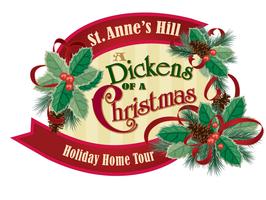 This past Friday night, my daughter and I went back in time. Well, not really, and certainly not like the characters in my books, but in a figurative sense, with help from the residents and volunteers of the St. Anne’s Hill Historic Society.
This past Friday night, my daughter and I went back in time. Well, not really, and certainly not like the characters in my books, but in a figurative sense, with help from the residents and volunteers of the St. Anne’s Hill Historic Society.
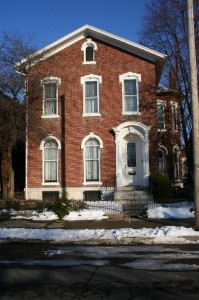
48 High St. Gallery
Every year since 1986, the group has conducted a tour of homes in their historic Dayton neighborhood. It includes a walking tour of the area, led by tour guides in capes and top hats. Most of the homes are from the Victorian era or the early 20th century, and are lavishly decorated. The homeowners were friendly and enthusiastic, and happy to tell their homes’ stories and answer visitors’ questions. All who were asked, permitted us to take photos inside as well.
Our tour started at 5PM, when it was getting dark, so none of the photos I took turned out well. So most of the photos shown are from the St. Anne’s Hill website, which features a very cool online tour. The 2011 “Dickens of a Christmas” Tour started at the 48 High Street Gallery, which is home to the Dayton Society of Painters and Sculptors.
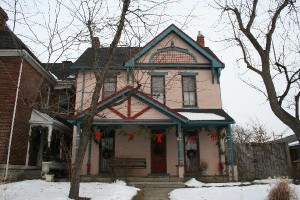
The first residence in the St. Anne's Hill neighborhood
St. Anne’s Hill was one of the first neighborhoods plotted outside of the immediate downtown area, by Daniel Cooper, one of the early city planners, in the early nineteenth century (sources vary on exactly when this happened). The first reference to the area as “St. Anne’s Hill” appeared in newspaper ads for a greenhouse in the early 1830s. Where the name came from remains unknown.
A Swedish botanist named Eugene Dutoit built the first residence, a farmhouse, on his 111-acre farm and orchard on the north side of Fifth Street. The original house still stands at 222 Dutoit Street.
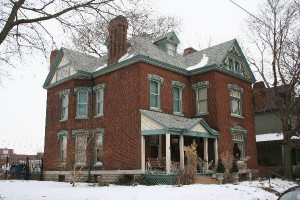
The Dragon House
One of the first homes we visited was called “the Dragon House.” Located at 629 McLain, the turn-of-the-century Victorian house was called such because it once had a metal dragon figure mounted above the porch (if I recall the story correctly). The homeowner still has the dragon, stashed away in the basement waiting to be restored. What was really cool, was the address numbers were formed of dragons! Unfortunately, my photo didn’t turn out, and they’re too small to see in this one. The interior of the home sports some amazing woodwork, that reminded me of the interiors of the Piatt Castles. It was also full of beautiful, restored antique furniture. My daughter says she wants to buy the Dragon House. I told her she’d better win the lottery LOL. However, there was a flyer lying on the newel post that stated the owner is planning to put it up for sale this spring.
The majority of the neighborhood was built by craftsmen and industrialists. When the original Dutoit farm was split up and developed, much of the houses were smaller, simpler homes for working-class families. With original construction dates ranging from the 1830s to the 1960s (just a few of those!), there’s a lot of diversity in the architecture, yet it all goes together.
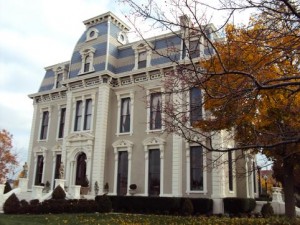
The Bossler Mansion
It was interesting to see how some of the homes were decorated, furnished, and remodeled inside, particularly the three smaller homes we visited on Henry Street. These had very contemporary-styled decor, or an eclectic mix of antique and modern furnishings. All of the kitchens and bathrooms (that we saw) had been updated, and some were very modern. My daughter was drooling at the claw-footed bathtubs in some of the homes.
The tour concluded at the Bossler Mansion, where servers in Victorian garb served coffee and homemade bread pudding. This Second Empire-style home was built in 1869 by Marcus Bossler, a builder and stone worker, who lost the home a few years later in order to avoid bankruptcy caused by another project. The mansion was later divided into thirteen apartments, several of which were still occupied when Lee Smithson, the current owner, purchased the house in 1980. Mr. Smithson spent the next five years overseeing a complete restoration, doing much of the work himself. An accomplished chemist retired from Wright-Patterson Air Force Base, Mr. Smithson is also a foodie, and has catered numerous weddings and other events at the Bossler Mansion. He resides in the third floor, and even allowed visitors into his personal space. This included the cupola, from which we could see a dramatic view of the city – probably one of the best around!
If you live in the area and are interested in history, the St. Anne’s Hill Christmas tour is a must-see. I’d like to go again, preferably during daylight hours so I can get a better view of the homes’ exteriors and maybe some decent photos. The $20 tour admission was money well spent, and will go toward the Historic Society’s continued work in preserving their neighborhood.
If you’re in the Dayton area, have you ever toured St. Anne’s Hill? I’ve done my own driving tours before, as one of my books’ main characters lives there (in 1905, on a fictitious street). Walking the neighborhood and talking with the residents adds a whole new perspective! If you don’t live in the area, does your town offer something similar, and have you taken advantage of the opportunity?
More at the My Town Monday blog

